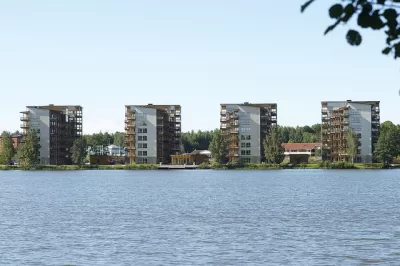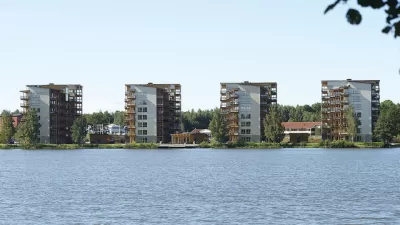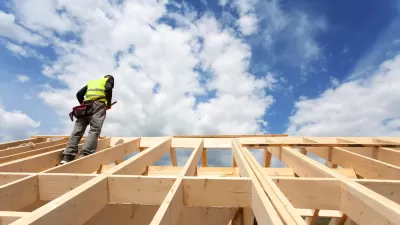Green building practices are advancing quickly. Here is a sample of best practices in choosing the most sustainable materials for the job.

It's an often-cited fact that buildings account for a substantial percentage of CO2 emissions. For example, the U.S. Environmental Protection Agency (EPA) notes that commercial and residential buildings accounted for more than 11% of greenhouse gas emissions in 2017.
That reality, combined with the trend of people wanting to live in sustainable places, has pushed city planners and design professionals to find the best green building materials for projects, and continue to refine how zoning and building codes include materials in green building best practices.
Besides pleasing individuals with sustainable mindsets, green building materials are already having a positive impact on emissions reductions. Statistics from National Geographic say that, compared to conventional buildings, the ones built with green materials have reduced CO2 emissions by 34%.
Another approach to sustainable design claims that the greenest buildings already exist. That’s the stance taken by historic preservations. They strive to leave buildings in place, knowing that’s the best option for emissions and the environment in general. But, another possibility—which doesn’t come close to the measures taken by historic preservationists—is to salvage old materials to build new buildings. For example, German engineers are working on a method of creating new materials from recycled rubble.
Some relatively new changes in city planners’ roles enabled those professionals to gain more influence on building projects’ materials. Traditionally, the zoning codes that city planners crafted and enforced primarily related to building uses—not the materials selected during construction. In contrast, architects and engineers dealt with building codes, which did encompass the materials used.
However, a more recent type called a form-based code concerns a building’s form first and its use second. The goal is to make a building that has a community’s vision and future uses in mind. Conversely, conventional zoning codes dictated uses for private land.
Form-based codes are growing in popularity. However, for now, most of a city planner’s involvement in building materials centers on being a collaborative partner to a project’s engineers and architects. Then, city planners can codify and enforce eco-friendly options for their projects. Here are four materials those professionals might collectively consider:
1. Wood
Wood is a green building material if care is taken to source it sustainably. For example, sustainable wood comes from forests where environmental stewards strategically remove trees to prevent damage to the underlying ecosystem.
In British Columbia, Canada, city planners use wood to build skyscrapers. Government documents show there are nearly 500 timber mid-rise buildings in various development stages across the country. Canada has hundreds of millions of hectares of land, and the majority of harvesting happens in British Columbia. There, a practice called clear-cutting strips forests of old-growth trees.
Architects are helping to limit clear cutting using many smaller pieces of wood for their buildings, aggregating the material to make it appear similar to old-growth trees. They say this method significantly cuts down on environmental damage. Plans are also underway to build a wooden skyscraper in Tokyo.
Also, at a recent meeting of the American Chemical Society, researchers discussed how they came up with a specially treated transparent timber—a potential replacement for traditional windows. They say the wood absorbs and releases heat, which could help building occupants save on heating costs.
Such progress with wood could forever redefine how people use the material for their building projects, and give them more options for doing so in eco-friendly ways.
2. Bamboo
The bamboo plant is naturally pest-resistant and 100% biodegradable. Plus, it absorbs five times more carbon dioxide than similar plants. In developing countries, bamboo is a popular material for homes because it's strong and not prone to water damage, such as warping.
One recent social housing project in rural Mexico involved using a prefabricated bamboo frame and a process that community members could replicate. When city planners want their bamboo building practices to be as sustainable as possible, it's essential to pay attention to the source location. It's best if the distance traveled is shorter.
The ideal option would be to use local bamboo, if available. For this housing project, the organizers did the next best thing by getting U.S-sourced materials They built the 60-square-meter residence in less than a week and used the local labor market to help. Besides the frame, the house has bamboo shutters, doors and wall panels.
If other projects like this one also show the promise of using bamboo for buildings, planning and building officials may begin to consider it more often. If the building processes are as simple as the example above, they could also empower people to create their abodes with minimal assistance.
3. Polyaspartic Coatings
Polyaspartic coatings are a resinous floor system solution and a lower volatile organic compound (VOC) option. This means that they emit fewer pollutants during the application, making it a greener option.
New advancements allow users to apply single coats without a primer, making it an ideal choice for people who want to maintain their flooring with limited downtime. Plus, polyaspartic coatings dry in a matter of hours rather than days, and the result is a well-protected, high-gloss covering that's ideal for use in heavy-traffic areas.
Epoxy is perhaps the best-known resinous floor coating, but one of the downsides of it is the long drying time. So, people often use polyaspartic layers as alternatives to epoxy.
In one case, the meat department of a grocery store wanted to revamp the flooring after most of an epoxy coating installed years ago had peeled up. A mixture of polyaspartic coating and silica sand dried quickly enough that workers installed it immediately after closing, and the area was ready for business the following morning.
Polyaspartic coatings also work well for industrial maintenance, such as when applied to bridges and structural steel.
The weather-resistant and fast-drying characteristics make polyaspartic coatings popular for a variety of uses, and it’s becoming a trusted best practice for green building
4. Carbon-Injected Concrete
In arguably one of the most creative ways to reduce carbon emissions, some companies offer carbon-injected concrete. A Canadian startup called CarbonCure inserts captured CO2 into concrete, where it stays permanently. The eco-friendly technique actually strengthens the concrete.
The Hawaii Department of Transportation is one organization partnering with CarbonCure for a test that compares the performance of the carbon-filled material with standard concrete for a road construction project. The amount of concrete poured during this trial will save 1,500 pounds of carbon dioxide. The outcome could inspire other authorities to investigate this carbon-injected material.
Planet-Protecting Possibilities
This list provides a sampling of how zoning and building codes can integrate green materials into current or future projects. More solutions will undoubtedly become available as technologies develop, and the codes planners are tasked with enforcing will have to keep up.

Alabama: Trump Terminates Settlements for Black Communities Harmed By Raw Sewage
Trump deemed the landmark civil rights agreement “illegal DEI and environmental justice policy.”

Planetizen Federal Action Tracker
A weekly monitor of how Trump’s orders and actions are impacting planners and planning in America.

How Atlanta Built 7,000 Housing Units in 3 Years
The city’s comprehensive, neighborhood-focused housing strategy focuses on identifying properties and land that can be repurposed for housing and encouraging development in underserved neighborhoods.

In Both Crashes and Crime, Public Transportation is Far Safer than Driving
Contrary to popular assumptions, public transportation has far lower crash and crime rates than automobile travel. For safer communities, improve and encourage transit travel.

Report: Zoning Reforms Should Complement Nashville’s Ambitious Transit Plan
Without reform, restrictive zoning codes will limit the impact of the city’s planned transit expansion and could exclude some of the residents who depend on transit the most.

Judge Orders Release of Frozen IRA, IIJA Funding
The decision is a victory for environmental groups who charged that freezing funds for critical infrastructure and disaster response programs caused “real and irreparable harm” to communities.
Urban Design for Planners 1: Software Tools
This six-course series explores essential urban design concepts using open source software and equips planners with the tools they need to participate fully in the urban design process.
Planning for Universal Design
Learn the tools for implementing Universal Design in planning regulations.
Caltrans
Smith Gee Studio
Institute for Housing and Urban Development Studies (IHS)
City of Grandview
Harvard GSD Executive Education
Toledo-Lucas County Plan Commissions
Salt Lake City
NYU Wagner Graduate School of Public Service





























